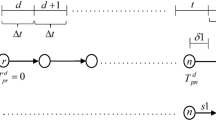Abstract
In the development of a deployable real-time DTA system, macroscopic analytical DTA models are employed to provide credible benchmarks for evaluating simulation-based DTA models. To achieve this goal, an analytical link-based DTA model and a path-based DTA model are developed to incorporat the rolling horizon implementation, traffic control models, and on-line calibration process. A benchmark evaluation for simulation-based DTA models is the intended agenda of the proposed model, algorithm, and implementation approach. Specifically, a path-based DTA model is discussed in this paper to illustrate the complicated process of model and algorithm development. This model is formulated as a variational inequality (VI) and can be solved efficiently to convergence by the proposed relaxation algorithm. The incorporation of rolling horizon implementation, traffic control models, and on-line calibration makes the proposed model and algorithm more appropriate for bench-mark evaluation for simulation-based DTA models. According to different assumptions of travelers’ route choice behavior, travelers are classified into three different classes, including fixed (predetermined) route class stochastic dynamic user-optimal (SDUO) class, and dynamic user-optimal (DUO) class. The solution steps and the combined algorithm are discussed in detail. Computational results are also reported and analyzed.
Similar content being viewed by others
References
Allsop, R.E. (1974). Some Probabilities for Using Traffic Control to Influence Trip Distribution and Route Choice.Proc. the Sixth International Symposium on Transportation and Traffic Theory, Sydney, Australia, pp. 345–374, Published by Elsevier, New York
Ben-Akiva, M., Bierlaire, M., Bottom, J., Koutsopoulos, H.N. and Mishalani, R.G. (1997). Development of a route guidance generation system for real-time application.Proceedings of the 8th International Federation of Automatic Control Symposium on Transportation Systems IFAC, Chania, Greece, forthcoming.
Ben-Akiva, M., Koutsopoulos, H. N., and Mukundan, A. (1994). “A Dynamic Traffic Model System for ATMS/ATIS Operations,”IVHS Journal, 2(1)
Chen, H.-K. and Hsueh, C.-F. (1997). Combining signal timing plan and dynamic traffic assignment. In Paper Presented at the 76tn Annual Transporation Research Board Meeting, Washington, D.C.
Dafermos, S. (1982). The General Multimodal Equilibrium Problem with Elastic Demand.Networks, 12, pp. 57–72.
Danganzo, C.F. and Sheffi, Y. (1977). On stochastic models of traffic assignment.Transpn. Sci., 11, pp. 253–274.
Friesz, T., D. Bernstein, T. Smith, R. Tobin, B. Wie. (1993). A Variational Inequality Formulations of the Dynamic Network User Equilibrium Problem. Opns. Res., 41, pp. 179–191.
Frank, M. and Wolfe P (1952). An algorithm for quadratic programming.Naval Res. Logistics Quarterly, 3, pp. 95–110.
Chen, H.-K. and Hsueh, C.-F. (1997). Combining signal timing plan and dynamic traffic assignment. In Paper Presented at the 76th Annual Transportation Research Board Meeting, Washington, D.C.
Hicks, J., Boyce, D.E. and Sen, A. (1992).Static network equilibrium models and analyses for the design of dynamic route guidance systems. Final report to the Illinois Department of Transportation, Urban Transportation Center, University of Illinois, Chicago.
Janson, B.N. (1991a). Dynamic Traffic Assignment for Urban Networks, Transportation Research, 25B, pp. 143–161.
Janson, B.N. (1991b). A Convergent Algorithm for Dynamic Traffic Assignment, Transportation Research Record, 1328, pp. 69–80.
Janson, B.N. (1995). A Quasi-Continuous Dynamic Traffic Assignment Model, Transportation Research Record, 1493, pp. 199–206.
Jayakrishnan, R., Mahmassani, H.S. and Hu, T.-Y. (1994). An evaluation tool for advanced traffic information and management systems in urban networks.Transpn. Res., 2C, pp. 129–147.
Lee, Der-Horng. (1996). Formulation and Solution of A Dynamic User-Optimal Route Choice Model on A Large-Scale Traffic Network. Ph.D. Thesis. University of Illinois-Chicago, Chicago, Il.
Mahmassani, H.S. and Hawas, Y. (1997). Data requirement for development, calibration of dynamic traffic models, and algorithms for ATMS/ATIS. Presented at the 76th Annual Meeting of the Transportation Research Board, Washington, DC.
Mahmasani, H.S., Peeta, S., Hu, T.-Y. and Ziliaskopoulos, A. (1993). Dynamic traffic assignment with multiple user classes for real-time ATIS/ATMS applications.Large Urban Systems, Proceedings of the Advanced Traffic management Conference, Yagar, S. and Santiago, A.J., eds., Federal Highway Administration, US Department of Transportation, Washington, DC, pp. 91–114.
Nagurney, A. (19930.Network economics: a variational inequality approach. Kluwer Academic Publishers, Norwell, Massachusetts.
Peeta, S. And Mahamassani, H.S. (1995). Multiple User Classes Real—Time Traffic Assignment for Online Operations: A Rolling Horizon Solution Framework.Transpn. Res., 3C, pp. 83–98.
An, B. and Boyce, D. (1996).Modeling dynamic transportation networks. Springer-Verlag, Heidelberg.
Ran, B., Lee, D. H., Shin, S. I., Miaou, S. P. (1998). A Rolling Horizon Implementation For An Analytical Dynamic Traffic Assignment Model. In Paper Presented at the 77th Annual Transportation Research Board Meeting, Washington, D.C.
Sheffi, Y. and Powell, W.B. (1982). An algorithm for the equilibrium assignment problem with random link times.Networks, 12, pp. 191–207.
Van Aerde, M. (1994). INTEGRATION: A Model for Simulation Integrated Traffic Networks. User’s Guide for Model Version 1.5g. M. Van Aerde and Associates, Ltd. And Transportation Systems Research Group, Queen’s University, Kingston, Canada.
Wardrop, J. (1952). Some theoretical aspects of road traffic research.Proceedings of the Institute of Civil Engineers, Part II, 325–378.
Author information
Authors and Affiliations
Additional information
The manuscript for this paper was submitted for review on February 27, 1999.
Rights and permissions
About this article
Cite this article
Shin, M.S., Oh, R.S. & Choi, K. A path-based analytical dynamic traffic assignment model for real time evaluation of simulation based dynamic traffic assignment models. KSCE J Civ Eng 3, 213–231 (1999). https://doi.org/10.1007/BF02823808
Issue Date:
DOI: https://doi.org/10.1007/BF02823808




